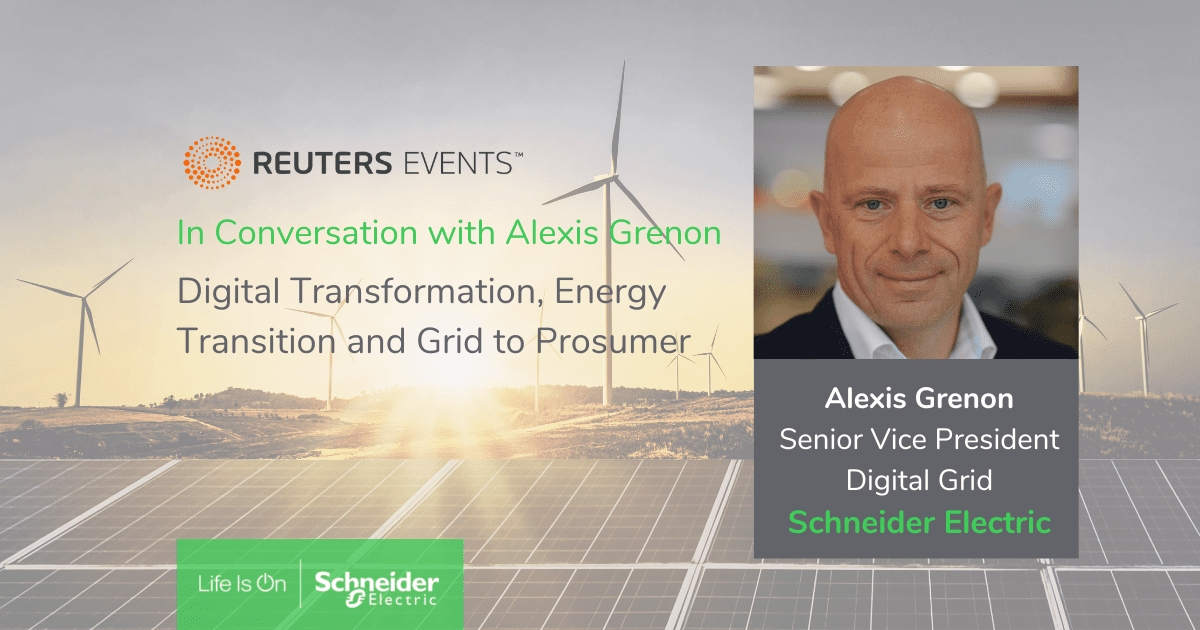The electricity sector is ripe for disruption as the race towards net-zero goals accelerates and the subsequent push within industries for electrification to replace fossil fuels strengthens. Electric grids – seen as the “energy transition backbone” – are forced to adapt and evolve with megatrends shaping the electricity sector.
This is the first post in a series on the colossal shift underway from the control center to the prosumer. In this post, the megatrends molding the electricity industry are put under the microscope and we examine how the grid will need to adapt and evolve with these factors.
Megatrends shaping the future of grids and the role of digitalization
1. DER integration
Distributed Energy Resources (DER) connections to the grid are rapidly increasing. The International Energy Agency estimates that from 2017 to 2020, there was 179 GW of distributed solar added, while the stock of electric vehicles (EVs) tripled to over 11 million. Moreover, the boom in DER looks set to continue due to falling prices from economies of scale.
As DER integration soars, it’s essential to realize it can provide grid flexibility and be a key driver in shifting to a prosumer economy. Batteries, including those in EVs, are versatile resources. Home battery pairing allows consumers to maximize low-cost renewable energy generated by rooftop solar. Such capabilities make battery storage integral to the rising number of virtual power plant projects. We also see a rise in grid-interactive efficient buildings that integrate a range of DERs to optimize building energy ‘prosumption.’
Electricity systems require more sophisticated management systems to properly manage the increased complexity of more DER penetration. To address these challenges distribution utilities started a journey to digitize their network management system by implementing solutions such as ADMS and DERMS. Our EcoStruxure DERMS (full form DERMS), for example, provides a solution by enabling critical capabilities, such as monitoring and estimating the current and the future state of DER, modeling real-time and forecasted activity, and optimizing management and control, which can help reduce operational costs.
2. New revenue models
Distribution utilities have to comply with local and regional regulations. Energy regulators control the utility spending, review their performance against targets, and adjust their remuneration level. While many utilities are still controlled by a very traditional, risk-free “cost-plus” regulation, a growing number of them are challenged by innovative regulation based on elements like performance-based incentives, TOTEX (CAPEX + OPEX) equalization in allowed spending. As an example, since 2015, the UK has been the first country to introduce a new regulation called RIIO (Revenues equal Innovation, Incentives and Outputs), rewarding performance and opening avenues for innovation and adoption of new technologies by Distribution System Operators. As a result, new planning options like flexible (non-firm) connections, dynamic voltage regulation, market-based use of flexibility have been introduced, enabled by Active Network Management (ANM) schemes. Similarly, in the US, The FERC Order 2222 from the Federal Energy Regulatory Commission commands grid and electricity market operators to allow DERs to participate in wholesale markets without barriers. This is a new business area where distribution utilities may be involved in some states, depending on local regulation.
Our Digital Grid solutions help distribution utilities transform their planning and operations both proactively and in response to regulatory evolution, for greater operational efficiency and customer satisfaction.
3. Aging infrastructure
Over the next ten years, roughly 20% of worldwide electricity grids need replacing. Their continuous operation has led to stressed equipment, while grid disturbances have caused significant equipment degradation. The issue of aging infrastructure is magnified by the fact that ever-changing energy demand requires an agile and robust system. For instance, in the U.S., a massive investment plan has been announced under the Infrastructure Investment and Jobs Act to support the needed T&D grid modernization.
Currently, the continuous flow of data from the design, operations, and maintenance teams is not utilized cohesively throughout the grid’s lifecycle. Using new technology, such as digital twins, can replicate specific stages of the lifecycle and help share data across the lifecycle to better integrate asset management and ADMS software. This can eliminate a significant amount of recurring work for operators and eliminate inefficiencies across the grid lifecycle.
Our ArcFM XI ecosystem is an ecosystem of applications that work together to help make your organization more efficient by better supporting disconnected workflows, thus improving performance and the ability to collaborate on information and pass it through your organization’s workflow.
4. Cybersecurity risks
Cybersecurity risk is a growing concern for the electricity sector. Amid increasing digitalization and use of the Internet for operational technologies, the threat posed by ransomware and other cyberattacks is soaring. With geopolitical tensions mounting, companies are increasingly warned to be thoroughly protected against any cyberattack.
To ensure grid reliability and dependability, its physical robustness should be strengthened, and cybersecurity layers added. Setting up scalable and interoperable architecture that integrates central and edge levels to connect the technologies between digital grid layers will help grids fight off cyberattacks. It is also vital that grids select a flexible architecture ready for future evolutions. Putting a data or event-driven architecture in place can support real-time reaction and adaptation of operations.
For us at Schneider Electric, cybersecurity is of utmost importance and hence our comprehensive cybersecurity expertise spans across IT and OT systems, to offer our customers a united front to fight threats, maximize service continuity, boost reliability and performance, and achieve compliance based on IEC standards.
Our turnkey solutions are developed with certified cybersecurity processes and procedures for engineering, commissioning, and maintenance with IEC 62443-2-4
5. Data as the new energy
Data volumes are growing globally at an astronomical pace. The International Data Corporation predicts data volumes will grow from 33 zettabytes in 2018 to 175 zettabytes in 2025, representing a 530% increase in seven years. This trend also applies to the energy sector, which is being revolutionized by big data. Mordor Intelligence predicts that the big data analytics market in the energy sector will grow at a CAGR of over 11% from 2021 to 2026 as energy companies seek to improve energy efficiency.
Grids must embrace data-powered insights as they can create new business value through better infrastructure management, more efficient operations, and improved services delivered to end customers. Leveraging data can automate the supervision system, optimize grid maintenance, and improve grid performance while ensuring stability and security, but it is important also that an integrated approach is used for managing the lifecycle of the grid.
A data-driven grid can also be combined with artificial intelligence to optimize CapEx, reduce OpEx, and ultimately drive the transition from consumer to prosumer.
Looking ahead
Finding solutions to the megatrends shaping the electricity sector can feel overwhelming. It’s important to remember that digital transformation is incremental and does not happen overnight. It requires new ways to engage, plan and design, optimize and maintain, and analyze and automate, all with a stepwise, coordinated approach.
Although utilities seek to be more innovative and agile, the myriad of technologies present a complex business landscape with evolving regulations. What’s more, there is no universal roadmap for migration from the present to the envisioned future. At the same time, utilities will need to provide many new services beyond delivery of electricity. However, they are often uncertain about the steps needed to take advantage of these opportunities.
Given the magnitude of the transformation there’s no way of addressing these massive emerging grid challenges alone. There needs to be a spirit of partnership and collaboration.
To help advance the industry and address the needs of stakeholders, Schneider Electric introduced an end-to-end approach to DER management: “Grid to Prosumer.” The objective of this approach is to provide electric utilities the ability to proactively address their organization’s goals (e.g., decarbonization and sustainability, enhanced resilience, and flexibility, all while maintaining high reliability) and advance their digital transformation journey.
Our Grid to Prosumer approach combines the three pillars of DER management – Grid Optimization, Flexibility Services, and Prosumer Engagement.
- Grid Optimization – Grid-aware technical constraint management with the goal of ensuring that the grid can support the adoption and dynamic nature of grid edge connected DER.
- Flexibility Services – Prosumer-aware economical constraint management with the goal of maximizing the value of beyond the meter DER.
- Prosumer Engagement – With respect to distribution utilities and retail energy providers, most now understand that they need to better engage with their prosumer customers to improve their experience and enhance prosumer centricity and personalization.
Discover more about our vision for Grid to Prosumer as I will dive deeper into this approach in my upcoming blogs.
I also invite you to watch my latest conversation with Reuters, where we talked about topics like Electricity 4.0, the grids of the future, and the rise of the prosumer. Check out the interview here.




